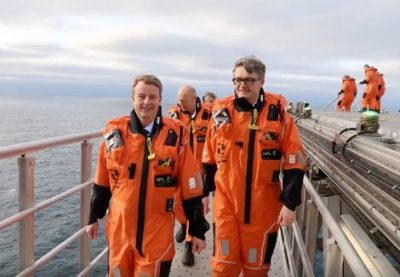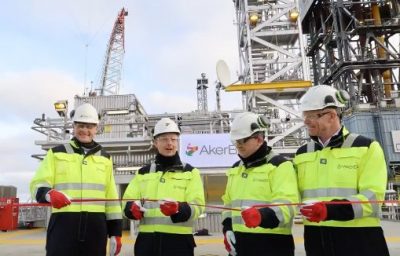Terje Søviknes, a veteran politician from the conservative Progress Party, made his North Sea debut as Norway’s new oil and energy minister this week when he officially opened the Ivar Aasen field, around 175 kilometers off Karmøy. Søviknes has already proven himself to be just as bullish on Norway’s oil industry as all his recent predecessors.

Søviknes recently replaced former Oil Minister Tord Lien, also from the Progress Party, who in turn replaced Ola Borten Moe from the Center Party in the former left-center goverment coalition. The Progress Party has held political power over the oil ministry since the current conservative coalition government took over in 2013.
The post of oil minister can land its occupants in controversy, given all the concerns over climate change and the environment. While Norway publicly boasts of ambitious programs to cut carbon emissions, the country continues to pump up fossil fuels and promotes more oil and gas exploration, also in sensitive Arctic areas. Søviknes, like his predecessors Lien and Moe, sees no paradox in that, and was full of upbeat remarks during his visit to Ivar Aasen on Monday.
“I want to congratulate operator AkerBP and its partners for delivering this project on time and within budget,” Søviknes declared. The partners on Ivar Aasen include Norway’s own Statoil, Bayerngas Norge, Wintershall Norge, VNG Norge, Lundin Norway and OKEA. Former Oil Minister Moe was involved in founding OKEA.
Newspaper Dagens Næringsliv (DN) noted on Tuesday that Aker boss Kjell Inge Røkke wasn’t at all happy when Ivar Aasen’s platform deck’s construction work was carried out in Singapore, instead of at his own Stord yard in Norway. Røkke wanted the job and claimed that having work done in foreign yards often resulted in delays and cost overruns, but that didn’t happen in this case. “The fears of delays and a burst budget are behind us now,” Øyvind Eriksen, Røkke’s right-hand man, told DN.

Eriksen was Søviknes’ host on board the Ivar Aasen platform in his capacity as chairman of AkerBP, which was formed last year through the merger of the Røkke-controlled firm Det norske oljeselskap and BP. DN noted that AkerBP has since jumped on the Oslo Stock Exchange in line with the price of oil, which has more than doubled since this time last year. Eriksen indicated that AkerBP expects more strong growth in the years to come.
That’s music to Søviknes’ ears, who has fretted that too many people have been “talking down the oil and gas industry in Norway.” Much attention, both within politics and business in Norway, has been paid to diversifying the country’s oil-dominated economy so that it will be better prepared when oil either runs out or becomes too unpopular. According to Søviknes and his predecessors, that won’t happen for a long time.
“The petroleum business will be Norway’s largest for many decades ahead,” Søviknes said during his remarks at the ceremonial opening of the field that actually began operating and producing oil on Christmas Eve. “But that’s on the assumption we have players with ambition, willingness and ability to further develop the considerable resources there are still enough of on the Norwegian Continental Shelf. Through the Ivar Aasen project, AkerBP is showing the way.”
That was music to Eriksen’s ears, and others on board the platform Monday. Eriksen is confident Ivar Aasen will produce around 190 million barrels of oil and oil equivalents over the next 20 years. Development and exports have been coordinated with the nearby Edvard Grieg field, just 10 kilometers to the southeast, with oil from both fields exported in a new and an existing pipeline to the Sture Terminal at Øygården in Hordaland. The gas is due to be exported via British fields. That should more than pay off investment costs of NOK 27.4 billion.
Eriksen sees Ivar Aasen as “a very good example of what AkerBP wants to do on the Norwegian Continental Shelf.” Søviknes views that as another prime example of Norway’s oil industy potential though its other fields in the North Sea, the Norwegian Sea and, more controversially, the Barents Sea. Johan Sverdrup is expected to generate more wealth in the North Sea and Søviknes told newspaper Bergens Tidende this week that he also has high hopes for the Johan Castberg field (formerly called Skrugard), north of the Snow White field in the contentious Arctic waters south of Bjørnøya. Søviknes also says he intends to carry out offensive exploration policies.
“We’ll be therefore launching a new exploration round before the summer, and will then be able to issue new exploration licenses next year,” Søviknes told Bergens Tidende this week. “My biggest contribution to boost activity in the industry is to dole out new exploration areas.” Søviknes wants Norway to produce the most oil possible, as quickly as possible, if the oil companies think it can be profitable. With costs down and oil prices back up at around USD 56 a barrel this week, it is profitable in the North Sea now and, much to the climate advocates and environmentalists’ distress, may well be in the Arctic soon.
newsinenglish.no/Nina Berglund

